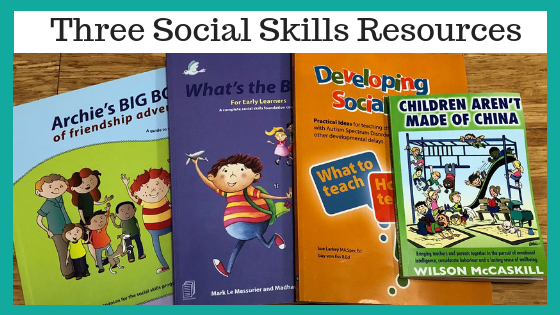There are numerous resources on social skills that help busy teachers to support students with disability. Here are three tried and tested Australian programs that can be utilised in combination with each other as each has a different target group.
‘What’s the Buzz?’ by Mark Le Messurier and Madhavi Nawana Parker
“What’s the Buzz’ consists of sixteen highly structured lessons that form a foundation social skills program for a small group or an entire class. This program can be utilised with all students, not just those with disability and is a must have resource for junior primary and primary classes. Each of the sixteen lessons can be split into mini-lessons and this program can then span the entire year. It is an evidence based social skills program that is widely used in schools and private practice. It comes in three levels (Early Learners, Primary and Older Students).
I’ve used the Early Learners ‘What’s the Buzz’ with a small group of teenagers with intellectual disability who appeared to really enjoy the stories, games and activities. The program is based on the idea that the teacher is a facilitator who presents social problems from Archie’s (the main character) perspective, and the students are guided to discuss issues and present a response. The program taps into the notion of ‘social thinking’, that is how to understand the thoughts, emotions, beliefs, intentions and knowledge of yourself and others to help interpret and respond through appropriate social interactions.
PROS
Was developed by a teacher and a psychologist who have an understanding of education and disability
It saves hours of planning due to the simple, easy to read format
Easy program for relief teachers to follow
Engaging and colourful.
Racial diversity is represented within the students in the stories
Low cost (approximately $80)
Parental support and involvement is built into the program
CONS
Like any program for students with disability, it requires minor adaptations such as visuals to support the key messages.
It is best suited for students who have strong receptive and expressive language skills.
Students with visible disabilities are not represented within the stories.
It may not be suited for students with significant intellectual or language delays.
‘Developing Social Skills’ by Sue Larkey and Gay von Ess
This book is a fabulous resource for children with autism and developmental delays. Unlike ‘What’s the Buzz?’ which has been designed for group instruction, ‘Developing Social Skills’ focusses on providing strategies for the individual rather than a group or the whole class. It is a starting point for a social skills program for students who are working toward foundation level. It covers areas such as voice level, personal space and body language, provides practical ideas, social scripts, visuals and worksheets that can be adapted for each individual. It relies on the Stop, Think, Do methodology to teach social skills. ‘Stop’ refers to the identification of the problem, ‘Think’ means think about the issue and ‘Do’ means to make the right choice. This framework, along with the headings of ‘Why teach this’ and ‘Ideas for Teaching’ provide structure to this text.
An aspect of this book that I find particularly helpful for students with disabilities is the five steps to teaching emotions. There is a focus on teaching the correlation between the student’s appearance and their feelings. For example, the students are guided to examine their visual indicators that they have a particular emotion and make connections between their appearance and feelings. For example if they are angry they may have muscles that feel tense and tight, their hands may be fisted and their face may red. They explore the situations that make them angry as well as ways that they can feel happy again.
PROS
Easy to follow
Inexpensive
It was developed by two special educators who have a strong understanding of teaching students with disability
This resource meets a need in the education space by catering for students with significant disabilities
CONS
The book has a self-published, amateur presentation.
A number of the websites listed in the book are no longer online
The writers of this book are considered experts in autism, but they do not identify as autistic. The disability community consider the lack of lived experience by ‘experts’ adds to the stigma associated with autism and suggest that only autistic people be considered experts.
‘Play is the Way’ by Wilson McCaskill
‘Play is the Way’ is a whole school methodology where social and emotional skills are taught through games, the careful use of language and five guiding principles which are referred to as ‘lift raft skills’. McCaskill states that it is suited for students with disability, but I believe this could be challenging for the teacher to make appropriate adaptations for those with significant disabilities. The games mirror different social situations where the students must work out a resolution to the problem and are a vehicle to drive the reflective language and life raft rules. The games are sequential and challenging with the aim of eliciting rich discussions. These discussions assist students to become aware of their emotional and physical states and to learn strategies to self-regulate. The teacher needs to ensure that the games continue to be challenging over time and may do this by changing the rules of the game by adding elements such as a blindfold, playing in silence and using a rubber chicken instead of a ball. There are key phrases that are used in this program such as ‘It takes great courage to follow the rules’ and ‘pursue your best no matter who you are working with’. There is much to like about this program and it has been embraced by many schools throughout Australia.
PROS
Minimum resources or financial investment are required to implement this program
This program provides far more than simple strategies as it challenges teachers to be reflective of their use of language in order to create a caring and safe environment.
CONS
This program could be challenging for students with language delays or intellectual disability due to the higher order language skills required to play the games. It requires major adjustments for many students with disability
It is not sensitive to students affected by trauma as McCaskill (2002 p. 63) states ‘Removing children and discussing things in private also removes the chance for observational learning’. Many students with disability have experienced trauma and may not have the skills to understand what can be disclosed publicly and what is best to discuss in private.
In Summary
I have utilised the above three programs to support my social skill programs. My preferred program is ‘What’s the Buzz’ as this can be utilised for broad ranges in age and ability with only minor adaptations. ‘Developing Social Skills’ is a helpful resource to develop individualised programs for students with significant delays. ‘Play is the Way’ is more suited to general education, but could be a helpful resource for those teaching students with disability who have strong language skills.




